| 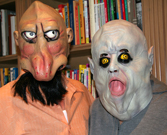 Effective
Teaching...
Effective
Teaching...
by Harry and Rosemary
Wong
October
2007
Taking the
Bite Out of Assessment
—Using Scoring Guides
Last month
you saw a picture of us playing Mexican Train. This month
we’re eating hamburgers…and scoring them!
We’re using a rubric or scoring guide to rate the quality
of the hamburgers.

As a birthday gift, we received an invitation to go to three
restaurants that had reputations for serving good hamburgers.
A scoring guide had to be devised so we could score each hamburger
fairly. Click here
to see the hamburger scoring guide.
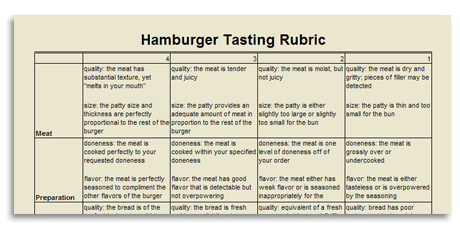
Scoring guides are familiar to students, as they use scoring
guides in the many games they play. By developing
their own scoring guides, your students will see the value of
having a scoring guide to assess their work.
Students can be involved in developing their own scoring guides.
They will see that a scoring guide
- specifies the level of performance achieved for a specific
category or task.
- can help them and their teachers define “quality.”
- can help them judge and revise their own work before handing
in assignments.
- communicates to them and their parents what is expected of
an assignment.
- is focused on producing good work, not on grading.
Picture your students with a study guideline in one hand with
the objectives for the lesson. With objectives, they know
what they are responsible for learning. For information
on structuring a lesson with objectives, see The First
Days of School, Unit D and our August 2003 column,
“How
to Start a Lesson Plan.”
Now picture your students with a scoring guide in the other hand
that spells out how their assignment will be scored, graded, or
assessed.
Just think. Yes, just think what
would happen to student learning
if the students knew what they were to learn,
and how they would be scored or graded?
They would know how to reach success and achievement.
Students fail when some teachers cover chapters, do activities
to entertain the students, or show videos that have no purpose
to a lesson. These teachers are more concerned with what
they put into a lesson, rather than what learning outcomes result
from the students. The students, thus, have no idea
what they are responsible for learning and how they will be assessed
for the quality of their work.
Scoring Guide for Listening
In our February 2007 column, “Students
Want a Sense of Direction,” we shared a scoring guide
used by Karen Rogers for determining how well students listen
in class to a presentation.
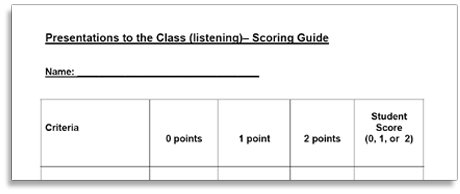
Just think how much more students will listen to a presentation
if they had a role in helping to develop this scoring guide?
Multimedia Is Everywhere
Starting in the fall of 2007, the University of Chicago’s
School of Business will begin requiring prospective students to
submit four pages of PowerPoint-like slides with their applications.
The purpose is to allow students to show off a creative side that
might not reveal itself in test scores, recommendations, and even
essays.
Rather than having the university dictate what is to be said
with a set of questions or outline, the applicant is given four
blank sheets of paper to be creative—a fact needed for success
in life.
Undergraduates already submit art work and videos with their
applications. Why not allow graduates the same latitude
to better identify the students with a creative spark.
First graders are more often computer savvy and are helping
to solve the high tech glitches in the classroom.
Children are brought up and surrounded by various forms of media.
They are motivated by and learn from media. Thus, teachers
must have knowledge of the use of media to be able to teach specific
standards.
The Etiwanda School District in Southern California has a set
of technology standards for its classes. The basic standard
is as follows:
Presentation provides students with an understanding of how
to
effectively use information technology tools to communicate
ideas
and information using a variety of media.
To meet this standard, objectives have been formulated for each
grade level.
Kindergarten and Grade 1
| The students will |
- present ideas using electronic documents.
|
| Grades 2 and 3 |
| |
| The students will |
- present ideas using a variety of information technology
tools.
- describe the components of electronic presentations.
|
| Grade 4 |
| |
| The students will |
- apply information technology to present information
to intended audiences.
- create multimedia documents.
- demonstrate their knowledge of the protocol for crediting
sources of information.
|
| Grade 5 |
| |
| The students will |
- demonstrate an understanding of how special effects
can be used to influence messages.
- create and present multimedia documents.
- use a variety of information technology tools in presentation.
demonstrate an understanding of how hypertext can enhance
presentations.
|
| Grade 6 |
| |
| The students will |
- demonstrate an understanding of how information technology
tools can be used to influence presentations.
- create and present multimedia documents for intended
audiences.
|
| Grade 7 |
| |
| The students will |
- synthesize information from a variety of electronic
sources for their presentations.
- apply the principles of good design when developing
electronic documents.
- develop interactive hypertext documents for presentation.
- produce multimedia presentation.
- analyze the impact of presentations on the intended
audiences.
|
| Grade 8 |
| |
| The students will |
- identify and consider ethical and legal issues when
presenting information.
- use a variety of software to present messages.
- demonstrate the ability to arrange information in different
forms to create new meaning.
- analyze the effects of information technology on presentations.
- describe the effect of multimedia presentations on intended
audiences.
|
Scoring Guide for a Multimedia Presentation
We have shared Norm Dannen in past columns.
The most recent was in October 2006, “Assessing
Student Progress With a Rubric.”
Norm designed a lesson to teach some short stories by Ernest
Hemingway. To see his lesson plan, click here.
In the story, The Snows of Kilimanjaro,
he had his students prepare a multimedia presentation.
The small group projects had the following structure all centered
around developing and marketing a vacation package to Africa:
| Students could select from these ideas for presenting the
vacation package: |
- a brochure (2-4 pages)
- a booklet (2-4 pages)
- a PowerPoint presentation (2-6 slides)
|
| Other criteria included the following: |
- Students will work in groups with four or five people.
- All will receive the same grade.
- Projects will be presented to the class.
|
| Students will consider the following in preparing their
vacation packages: |
- How long will the trip last?
- What is the order of the sites visited?
- What is the cost of your trip?
- What is the name of the tour?
- What is the geography/history of the site?
- What is the climate?
- What are the local customs?
- Why are you going to each of those places? (i.e., location’s
relationship to the short stories read).
|
To guide the students in their preparation of their multimedia
presentations, he gave them each a scoring guide. To see this
scoring guide, click here.
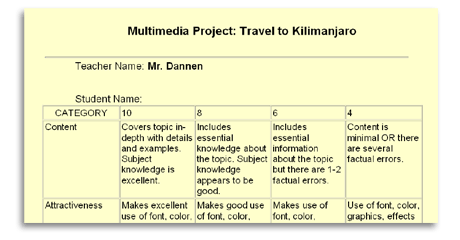
Both Karen Rogers’ guide for listening and Norm
Dannen’s scoring guide on multimedia presentations can be
applied to all classes.
To see the multimedia presentation a group of his students prepared,
click here.
A Career Choice He Would Not Hesitate to Make
Norm Dannen just started his third year as a teacher.
He worked for AT&T for 25 years and when they downsized, he
decided that he needed a new direction in his life.
Earlier in his career, he had taught high school English as a
way to pay for graduate school. He liked it so much that
he resolved to return to it one day. So, with this juncture
in his life, he enrolled in an alternative certification program,
New Pathways to Teaching in New Jersey (NPTNJ).
His first job was as a maternity leave replacement at Southern
Regional High School in Manahawkin, New Jersey. While he
was there, Norm attended an Alternative Path conference where
we (Harry) spoke. Norm shared his work with us. Norm
credits Dr. Tom Vona of the Alternate Path Program for teaching
him this work. What he shared became the subject of two
related articles on teachers.net dealing with lesson plans and
assessment strategies. (May
2006 and October
2006)
At the end of his first year of teaching, Norm was named the
2005-2006 First Year Teacher of the Year by the Southern Regional
High School District. He returned to Southern for the 2006-2007
school year. In the spring of 2007, a tenure-track teaching
position much closer to home became available and he applied for
it.
Within a month, he was offered a position teaching freshman English
at a newly opened career academy called Biotechnology High School,
run by the Monmouth County Vocational School District, which is
where he is now.
The reason the brief teaching career of Norm Dannen has been
shared with you is to show that new teachers can succeed rather
quickly. Our teachers.net articles are full of examples
of first year teachers who succeeded, literally, on their first
day as teachers. They began by knowing what to do.
Check the archive in the latest June column and scroll through
to read about these teachers. Use them as examples for your
success.
As Norm says, “Although my return to the classroom has
not been without hurdles, it has provided me with some of the
most rewarding experiences of my life. It has been a career
choice I would not hesitate to make again.”
The Taste of Success
Whether you are scoring hamburgers or multimedia presentations,
a guide to how content will be rated is essential.
While we did not share our scoring guide with the cook at our
burger joints, the restaurant was blind in knowing what we deemed
to be a good hamburger.
Students, on the other hand, need to know before the assignment
begins what is quality and what is not quality. Does the
bun matter or not? What demonstrates mastery of an objective—achievement
of the goal?
Students can’t be working without the ability to
savor success.
To introduce your class to a scoring guide, select something
appropriate for the ages of students and do an assignment with
them. For instance, ask the question who makes the best
bubble gum, brand A or brand B? Have input as to what constitutes
good bubble gum. Taste, quality of bubbles, chewiness, and
so on. Assign values to the degree of each quality.
(Of course, if chewing bubble gum for 15 minutes as a class project
is not going to work in your setting, select something to suit
your students and their limitations.)
Distribute the gum and let them chew away and assess the outcome.
They will come to understand how they can apply this to their
own assignments by looking at the quality of their work and knowing
where they need to improve. In their bubble gum ratings,
all criteria will not get the highest mark, but in a simple glance
of the scoring guide, students, teachers, and parents can easily
identity where the need for improvement lies.
As for our hamburger quest, we have one more to score.
If you want to know our winner for the best hamburger in the San
Francisco bay area, write and ask us at the end of the month.
We’ll be happy to let you know.
With a scoring guide, assessing for achievement becomes a palatable
task for all. No more heartburn and indigestion waiting
for grades. A scoring guide lists all the ingredients for
student success. Invite your students to taste achievement.
Bon appétit and Happy Halloween!
 For a printable version of this article click
here.
For a printable version of this article click
here.
Harry & Rosemary Wong products: http://www.harrywong.com/product/
Email Harry Wong: harrywong@teachers.net
Gazette Articles by Harry & Rosemary Wong:
If you spot a link that appears to be out-of-date, please alert us at webmaster@teachers.net!
- A Grateful Goodbye After 15 Years (Jun 2015)
- Love, Marriage, and Babies, Oh My! (May 2015)
- Retention Rate Is 100 Percent (Apr 2015)
- Teacher Effectiveness and Human Capital (Mar 2015)
- Training Teachers to Be Effective (Feb 2015)
- Making Deals Is Ineffective (Dec 2014 / Jan 2015)
- Retrieving and Carrying Electronic Devices (Nov 2014)
- Sharing to Succeed (Oct 2014)
- How a University Prepares Its Students (Sep 2014)
- Effective Teaching (Aug 2014)
- Your Future Is in Your Hands (June/July 2014)
- The Classroom Management Book (May 2014)
- When Students Succeed; Teachers Succeed (April 2014)
- Teaching New Teachers How to Succeed (March 2014)
- Execute and Praise (February 2014)
- Shaping a Solid Foundation (Dec 2013 / Jan 2014)
- The Most Misunderstood Word (November 2013)
- How to Start Class Every Day (October 2013)
- Prevention: The Key to Solving Discipline Problems (September 2013)
- Planning, Planning, Planning (August 2013)
- Are You THE One? (June / July 2013)
- Practical Examples That Work (May 2013)
- A Disability Is Not a Handicap (Apr 2013)
- Totally Inexcusable (Mar 2013)
- Be Proud of Public Education (Feb 2013)
- Structure Will Motivate Students (Dec 2012 / Jan2013)
- Orchestrating the Classroom (Nov 2012)
- The Lasting Impact of Instructional Coaching (Oct 2012)
- Learning, Laughing, and Leaving a Legacy (Sep 2012)
- Twenty-two, First Year, and Legit (Aug 2012)
- A Master Teacher of Teachers (June/July 2012)
- Where Going to School Means Success (May 2012)
- A Nationally Celebrated High School (Apr 2012)
- The Highest Rated School in New York City, Part 2 (Mar 2012)
- The Highest Rated School in New York City, Part 1 (Feb 2012)
- The Importance of Culture (Dec 2011 / Jan 2012)
- You Can Teach Classroom Management (Nov 2011)
- Seamless, Transparent, and Consistent (Oct 2011)
- Coaching Teachers to Be Effective Instructors (Sep 2011)
- How a Principal Creates a Culture of Consistency (Aug 2011)
- Graduation Begins in Your Classroom (June/July 2011)
- The Inspiration of a Mother (May 2011)
- How to Be an Effective Leader (Apr 2011)
- Learning Objectives: The Heart of Every Lesson (Mar 2011)
- Even Shakespeare Had Structure (Feb 2011)
- Effectiveness Defined: It's Not a Mystery (Dec 2010 / Jan 2011)
- Surviving Without a Principal (Nov 2010)
- Achieving Greatness: Locke Elementary School, Part 2 (Oct 2010)
- Teaching Greatness: Locke Elementary School, Part 1 (Sep 2010)
- Effective from the Start (Aug 2010)
- Ten Year Summary of Articles, 2000 to 2010 (June/July 2010)
- The Success of a Culture of Consistency (May 2010)
- Training Teachers to Be Effective (Apr 2010)
- Learning to Teach, Teaching to Learn (Mar 2010)
- Turning Teaching Dreams into Reality (Feb 2010)
- Dreams and Wishes Can Come True (Dec 2009 / Jan 2010)
- Success in a State Controlled School (Nov 2009)
- Inner City Is Not An Excuse (Oct 2009)
- Exceeding All Expectations (Sep 2009)
- Teachers Are the Difference (Aug 2009)
- Nine Year Summary of Articles, 2000 to 2009 (Jun/Jul 2009)
- Teachers Are the Greatest Assets (May 2009)
- The Tools for Success (Apr 2009)
- Assessing for Student Learning (Mar 2009)
- To Be an Effective Teacher Simply Copy and Paste (Feb 2009)
- The Sounds of Students Learning and Performing (Dec 2008)
- A School That Achieves Greatness (Nov 2008)
- Boaz City Schools: Professional Learning Teams (Oct 2008)
- It Was Something Close to a Miracle (Sep 2008)
- A Computer Teacher Shows the Way (Aug 2008)
- Eight Year Summary of Articles, 2000 to 2008 (Jun/Jul 2008)
- An Amazing Kindergarten Teacher (May 2008)
- Schools That Beat the Academic Odds (Apr 2008)
- Academic Coaching Produces More Effective Teachers (Mar 2008)
- Coaches Are More Effective than Mentors (Feb 2008)
- Wrapping the Year with Rap! (Dec 2007/Jan 2008)
- The Floating Teacher (Nov 2007)
- Taking the Bite Out of Assessment—Using Scoring Guides (Oct 2007)
- Ten Timely Tools for Success on the First Days of School (Sep 2007)
- First Day of School Script - in Spanish, Too! (Aug 2007)
- Seven Year Summary of Articles, 2000 to 2007 (Jun 2007)
- Effective Teachers End the Year Successfully (May 2007)
- Training Gen Y Teachers for Maximum Effectiveness (Apr 2007)
- Classroom Management Applies to All Teachers (Mar 2007)
- Students Want a Sense of Direction (Feb 2007)
- Rubrics in Two College Classes (Dec 2006/Jan 2007)
- How to Write a Rubric (Nov 2006)
- Assessing Student Progress with a Rubric (Oct 2006)
- A 92 Percent Homework Turn-in Rate (Sep 2006)
- Effective Teachers Are Proactive (Aug 2006)
- Five Year Summary of Articles (Jun 2006)
- Hitting the Bulls Eye as a Beginning Teacher (May 2006)
- They're Eager to Do the Assignments (Apr 2006)
- The Success of Special Ed Teachers (Mar 2006)
- What Teachers Have Accomplished (Feb 2006)
- Fifty Years Ago, The Legacy (Dec 2005/Jan 2006)
- The Emergency Teacher (Nov 2005)
- Classroom Management Is Not Discipline (Oct 2005)
- A Successful First Day Is No Secret (Sep 2005)
- The Most Important Factor (Aug 2005)
- Four Year Summary of Articles (Jul 2005)
- Improving Student Achievement Is Very Simple (Part 2) (Jun 2005)
- Improving Student Achievement Is Very Simple (Part 1) (May 2005)
- Never Cease to Learn (Apr 2005)
- His Classroom Is a Real Life Office (Mar 2005)
- The Power of Procedures (Feb 2005)
- The First Ten Days of School (Jan 2005)
- PowerPoint Procedures (Nov/Dec 2004)
- The Saints of Education (Oct 2004)
- How Procedures Saved a Teacher's Life (Sep 2004)
- How to Help Students with Their Assignments (Aug 2004)
- Three Year Summary of Articles (Jun/Jul 2004)
- His Students are All Certified (May 2004)
- What to Do When They Complain (Apr 2004)
- A Well-Oiled Learning Machine (Mar 2004)
- The Effective Teacher Adapts (Feb 2004)
- How to Start a Lesson Plan (Aug 2003)
- Applying for a Teaching Job in a Tight Market - Part 2 (Jun/Jul 2003)
- Applying for a Teaching Job in a Tight Market (May 2003)
- The Effective Substitute Teacher (Apr 2003)
- A First Day of School Script (Mar 2003)
- How to Retain New Teachers (Feb 2003)
- No Problem With Hurricane Lili (Dec 2002)
- A Class Size of 500 (Nov 2002)
- Effective Practices Apply to All Teachers (Oct 2002)
- Dispensing Materials in Fifteen Seconds (Sept 2002)
- How To Start School Successfully (Aug 2002)
- Teaching Procedures Is Teaching Expectations (June - July 2002)
- $50,000 to Replace Each Teacher (May 2002)
- Even Superintendents Do It (Apr 2002)
- Impossible, No Job Openings? (Mar 2002)
- A Stress Free Teacher (Feb 2002)
- A Most Effective School (Jan 2002)
- Van Gogh in Nine Hours (Dec 2001)
- The Effective Teacher Thinks (Nov 2001)
- How a Good University Can Help You (Sep 2001)
- How to Motivate Your Students (May 2001)
- How to Recognize Where You Want to Be (Apr 2001)
- What Successful New Teachers Are Taught (Mar 2001)
- A Journey of the Heart (Feb 2001)
- The Miracle of Teachers (Jan 2001)
- It's Not the Students. It's the Teacher. (Dec 2000)
- The First Five Minutes Are Critical (Nov 2000)
- How to Start a Class Effectively (Oct 2000)
- The Problem Is Not Discipline (Sep 2000)
- There Is Only One First Day of School (Aug 2000)
- Applying for Your First Job (Jul 2000)
- Your First Day (Jun 2000)
Browse through the latest posts from the Classroom Management
Chatboard...
|




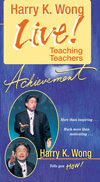
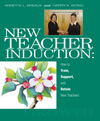
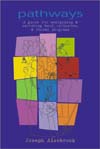


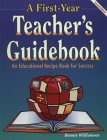
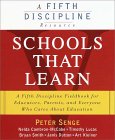

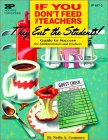
 Effective
Teaching...
Effective
Teaching... 


